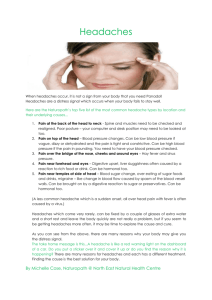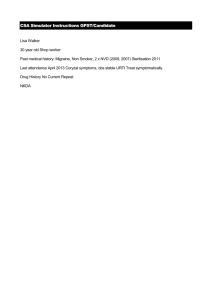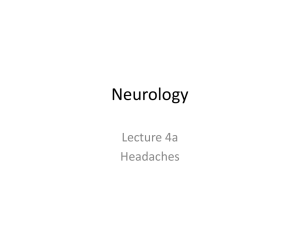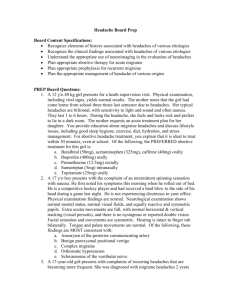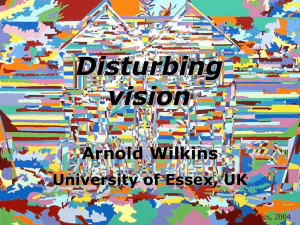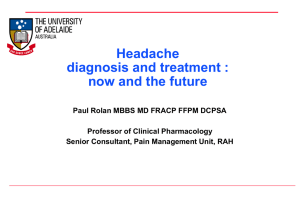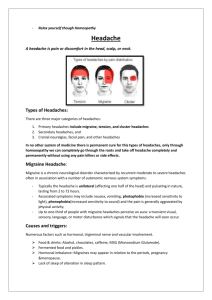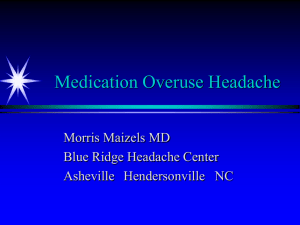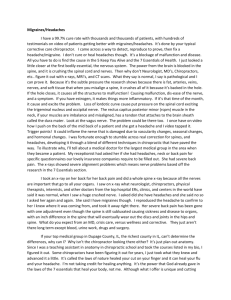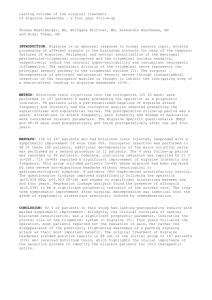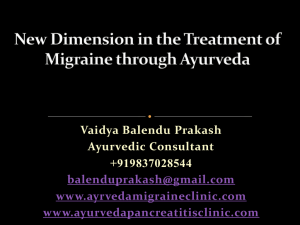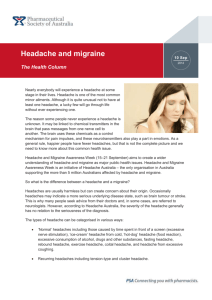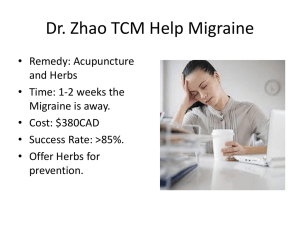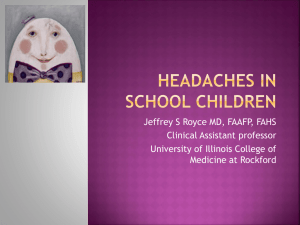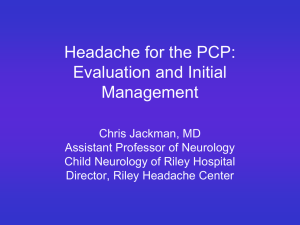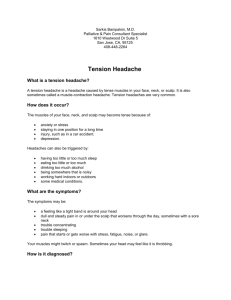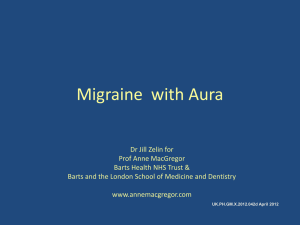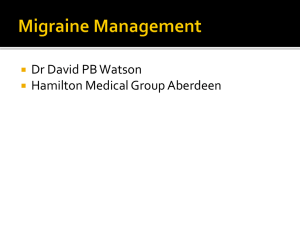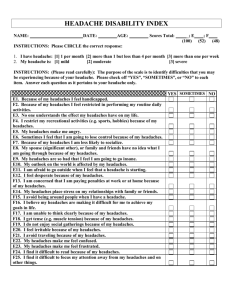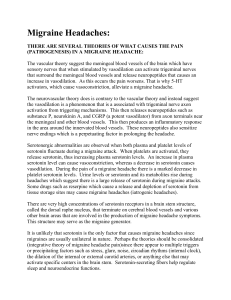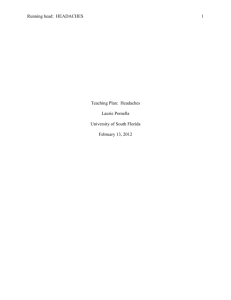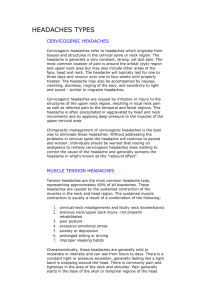Paediatric headaches 2010
advertisement
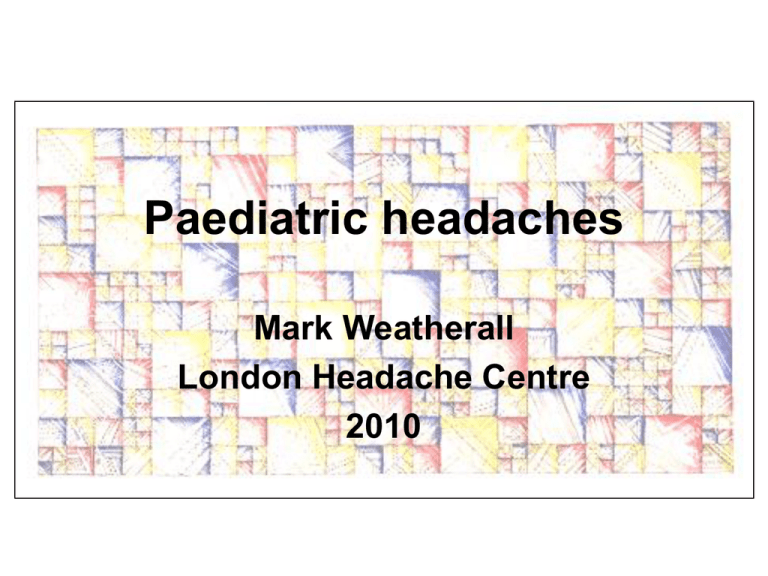
Paediatric headaches Mark Weatherall London Headache Centre 2010 Why is this important? • Headaches are common in children • Headaches often cause significant disability – affects home life & school performance – affects family relationships – affects relationships with peers Why is this important? • Headaches in children are underrecognised, misdiagnosed, and undertreated • Headaches may present differently in children • Accurate diagnosis and effective treatment – improve quality of life – prevent long-term disability & co-morbidity What headaches are we talking about? • Migraine* *with aura in 14-30% • Tension-type headache • • Cluster headache Other headaches Migraine • ICHD-II criteria (migraine without aura) – A recurrent headache disorder manifesting in attacks lasting 4-72 hours*. Typical characteristics of the headache are unilateral location, pulsating quality, moderate or severe intensity, aggravation by routine physical activity, and association with nausea and/or photophobia and phonophobia – * In children 1-72 hours is allowed Migraine • Difficulties in diagnosing migraine in children include: – shorter duration – more likely to be bilateral – difficulty in describing headache features and associated symptoms • must often be inferred from behaviour/drawings – evolution of the semiology of headaches over time Migraine • These difficulties are not confined to the paediatric population! • Study comparing physician diagnoses with ICHD-II – 4-72 hr duration: 61.9% met criteria – 1-72 hr duration: 71.9% met criteria – including bilaterality & other features such as difficulty thinking, light-headedness & fatigue: 88.4% met criteria Other headaches • TTH – common but rarely debilitating – true impact very difficult to gauge • Cluster headache – devastating until diagnosed – early onset cases rare • 18% report onset before 18 yr • 2% report onset before 10 yr Headaches are common • American Migraine Prevalence & Prevention Study – 120 000 households – 162 576 participants – mailed questionnaire on HAs & Rx – ICHD-II criteria used – overall 1-yr prevalence migraine • ♂ 5.6% • ♀ 17.1% Headaches are common • Subgroup analysis of adolescents (12-17 yr) – 1 yr prevalence of migraine 6.3% • ♂ 5% • ♀ 7.7% – utilization of medications by this group • • • • OTC 59.3% prescription medication only 16.5% OTC & prescription medication 22.1% current prophylactic treatments 10.6% Headaches are common • German 3/12 prevalence study – 2.6% migraine (ICHD-II criteria) – 6.9% if duration criteria reduced to 30 min – 12.6% probable migraine – 0.7% chronic migraine • Turkish prevalence questionnaire – 7.8% boys – 11.7% girls Headaches are common • Meta-analysis of paediatric headache studies 2002 by AAN group – >27 000 children – 37-51% significant HA by age 7 yrs – 57-82% significant HA by age 15 yrs Impact of headaches • Children with migraine lose on average 1½ weeks of school per year • Impact can be assessed using validated tools – PedMIDAS – PedQL Treatment • Accurate diagnosis • Comprehensive treatment plan – Explanation (and reassurance) – Lifestyle advice – Acute treatments – Prophylactic treatments – Biobehavioural therapies Treatment • Accurate diagnosis – Underlying headache phenotype • What was the headache originally like? – Triggers – Confounding factors • • • • Medication overuse Physical co-morbidities Psychological co-morbidities Life stresses Treatment • Explanation – common problem – physical, not just psychological problem • genetics, pathophysiology – treatable problem • identifying triggers, confounding factors • Reassurance for child and parents – … this is not a brain tumour … Treatment • Acute treatment – Goals: • sustained pain freedom • rapid return to normal activity – OTC • small trials show ibuprofen (7.5-10 mg/kg) superior to PCT + placebo • use early, at decent dose • avoid overuse (≤3 days/wk) Treatment • Acute treatment – Triptans • in UK only nasal sumatriptan licensed for adolescents • DBPCTs in adolescents exist for almotriptan, eletriptan, rizatriptan, sumatriptan, and zolmitriptan • effective (but high placebo rates…) and welltolerated • SUM/NAR database shows a linear correlation between age & efficacy of triptans Treatment • Prophylactic treatments – When to use them? • increased headache frequency • poor response to acute treatments • ? severe (including hemiplegic or basilar) MA – Goals: • reduce headache frequency • reduce headache-related disability • allow eventual return to acute treatment alone (or acute treatment + biobehavioural therapy) Treatment • Prophylactic treatments – pizotifen – beta-blockers – tricyclics – anticonvulsants – others • riboflavin (vitamin B2)* • coenzyme Q10 • butterbur extract * recent negative small PCRCT! • Prophylactic treatments – a paucity of evidence – Cochrane review 2003 found only two trials convincingly showing benefit of prophylactic treatment • Propranolol • Flunarizine – since then decent PCRCT for topiramate – recent negative PCRCT for SVP MR Treatment • Biobehavioural therapies – biofeedback – relaxation training • Treatment of co-morbidities – physical • sleep disorders – psychological • Counselling; family therapy The future? • Much more evidence is needed for – Acute treatments – Prophylactic treatments • monotherapy • combination therapies – Novel treatments • CGRP antagonists • More interest in the subject must be generated in 1°, 2°, and 3° care
